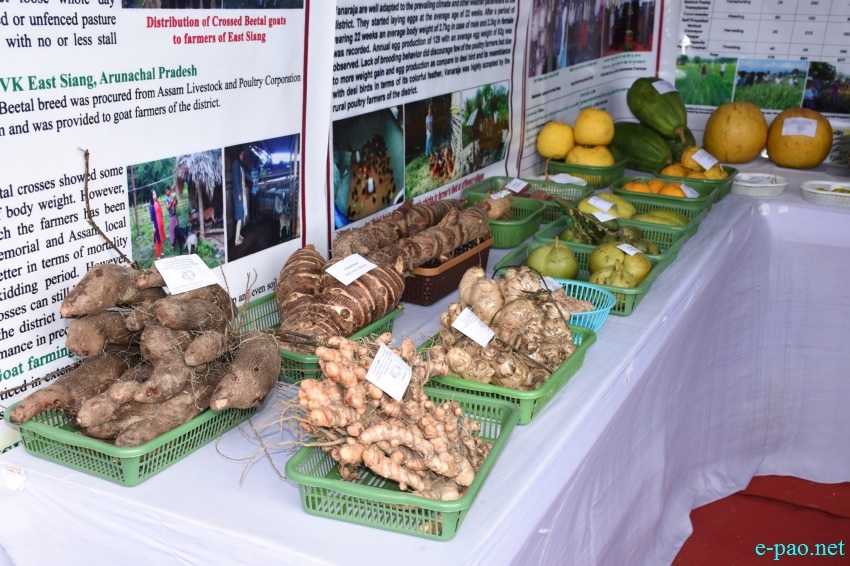Nutrition garden : For healthy family, healthy Nation
BN Hazarika *

Agri Fair 2018 at Central Agricultural University (CAU) at Iroisemba, Imphal in January 2019 :: Pix - Lamdamba Oinam
The main purpose of a nutrition garden is to provide the family required fresh vegetables and necessary fruits. If knowledge on nutrition aspect of different fruit and vegetable are reflected in such
garden it will truly be a nutrition garden.
The expert committee of Indian Council of Medical Research (ICMR) recommends that every individual should consume at least 300 g vegetables and 100g fresh fruits /day (green leaf vegetables – 50 g, other vegetables 200 g, roots and tubers -50 g.
In order to ensure a balanced diet, fruits and vegetables are to be grown on a piece of land available in a home near to the kitchen. This is known as the nutrition garden.
Layout of nutrition garden
* Select well drained sunny area at the backyard near water source. Perennial fruits and vegetables are located at one end of the garden so that they will not interfere with the intercultural operations of other crops and will not shade the nutrition garden. Usually grafts or dwarf varieties of fruit plants are preferred in a nutrition garden as they occupy only lesser space.
* Size and design of the garden depend on availability of land. However, the garden should preferably be rectangular in shape. Fencing is very important to protect the crop from stray animals and
poultry etc. Live fence is made up of plants like koronda.
* Selection of crops is governed by choice of the family, size of the garden and time available to devote in the garden. Select locally adaptable crops and varieties as far as possible. Preference should be given for raising pest and disease resistant varieties.
* 200 to 250 sq.m.area is sufficient for a five member family to supply 1.5 kg of vegetable per day. Quick growing fruit trees like banana, papaya, lemon etc should be planted in the northern side of
the garden and climbing type of vegetables like cucurbits, dolichosetc can be grown on the other side.
Layers, grafts and cuttings of fruit plants are used as planting materials. Dwarf varieties of banana or culinary banana are usually grown in a nutrition garden.
Assam lemon, kagzi lime, guava, pineapple, papaya, carambola, West Indian cherry etc. are some other fruit plants grown in a nutrition garden. The interspaces of these crops are utilized for growing ginger, turmeric, amorphophallus, coriander etc.
* To ensure steady and regular supply of vegetables, several sowing of a particular crop at short intervals should be done.
* Early maturing crops should be planted together in continuous beds so that they can be made available at once for putting late crops.
* Ridges which separate the beds may be utilized for growing root crops like radish, carrot, etc.
* Interspaces of the long duration crops like brinjal, tomato, chillies, etc. may be utilized for quick growing crops like spinach beet, lettuce, knolkhol etc.
* One to two compost pits should be dug in the corner of the garden to dispose of the plant residues which will be utilized as compost material.
* A bee hive is essential to ensure pollination in cross pollinated vegetables especially cucurbits. The farmer will get honey as an additional income.
Cropping pattern in kitchen garden
Mustard Leaf (Oct-Dec);
Late cabbage (Jan-April); Coriander (May); Okra (June-Sep)
Chinese cabbage + Lettuce (Oct-Dec); Coriander (Jan-Feb);
French Bean (March-June);
Amaranthus (July-Sep);
Broccoli (OctJan);
Chilli (Feb-July);
Palak (Aug-Sep);
Red Cabbage (Nov-Jan);
Brinjal (FebJuly);
Early Cauliflower (Aug-Oct);
Radish + Carrot + Fenugreek (Oct-Jan);
French Bean (Feb-June);
Amaranthus (July-Sep); Turnip +Beet root (Oct-Jan);
Chilli (Feb-May); Okra (June-Sep)
(Relay cropping); Garden Pea (Oct-Jan); Fenugreek (Feb-March);
Tomato (April-July);
Coriander (AugSep);
Tomato (Oct-Jan);
Okra (Feb-May);
Summer Squash (June-Sep);
Potato (Oct-Jan);
Cowpea (Feb-April);
Colocasia (May-Sep);
Perennial Local Vegetables
Intercropping of vegetables and spices with fruit crops
Pineapple (Var. Kew) + Local Coriander;
Lime (Var. Kagzi lime) + Onion;
Lemon (Var. Assam Lemon) + Garlic;
Carombola + Ginger (Var. Nadia);
Papaya (Var. PusaNanha)+ Turmeric (Var. Megha Turmeric-1);
For further details contact:
Public Relation & Media Management Cell,
CAU, Imphal
* BN Hazarika wrote this article for The Sangai Express
The writer is with Central Agricultural University,
College of Horticulture and Forestry,
Pasighat, Arunachal Pradesh
and can be contacted at bnhazarika13(AT)yahoo(DOT)co(DOT)in
This article was webcasted on December 08, 2020.
* Comments posted by users in this discussion thread and other parts of this site are opinions of the individuals posting them (whose user ID is displayed alongside) and not the views of e-pao.net. We strongly recommend that users exercise responsibility, sensitivity and caution over language while writing your opinions which will be seen and read by other users. Please read a complete Guideline on using comments on this website.